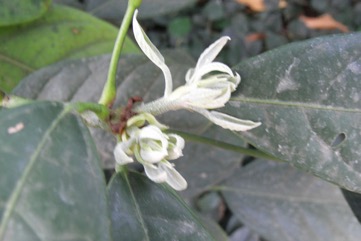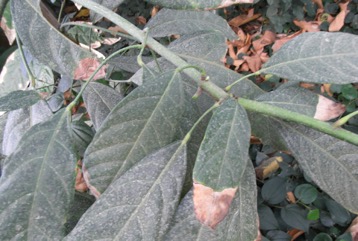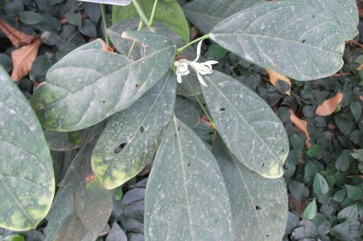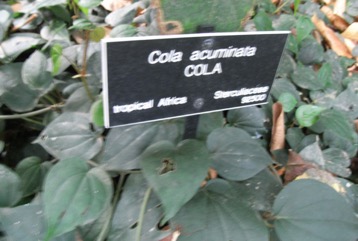Cola nut

It is a tropical plant. It suits the hot wet tropical lowlands. It will grow in sun or part shade. It is damaged by frost. It is best in fertile soil that are well-drained. It is native to West Africa. It suits hardiness zones 11-12. It cannot tolerate high pH.
Also known as:
Abata-kola, Angbonbole, Angbongbolia, Angbongo, Caffeine nut, Eme, Gbongbole, Gbongbolia, Gooranut, Gorra, Ibal, Ibong, Kola nut, Korra, Lebe, Libel, Lielu, Ligo, Liko, Liyelu, Moko, Ndigo, Ndigose, Noz-de-cola, Obi abata, Obi-igala, Oji, Oji awusa, Pohon kola manis, Ribey, Sombou
Synonyms
- Sterculia acuminata P. Beauv.
- and several others
Edible Portion
- Seeds, Herb, Flavouring, Fruit, Leaves
Where does Cola nut grow?
Found in: Africa, Angola, Asia, Australia, Benin, Brazil, Cameroon, Central Africa, Central African Republic, CAR, Central America, Colombia, Congo DR, Congo R, Cuba, Dominican Republic, East Africa, Equatorial-Guinea, Gabon, Grenada, Haiti, India, Indonesia, Nigeria, Sao Tome and Principe, SE Asia, Sierra Leone, South America, Sri Lanka, Togo, Venezuela, West Africa, West Indies, Zambia
Notes: There are about 125 Cola species. The seeds are rich in caffeine. Also put in the family Sterculiaceae. In Botanical Gardens in Slovenia presumably in a hot house.
Status: The seeds contain caffeine and theobromine.
Growing Cola nut
Cultivation: Plants are usually grown from seeds. Seed only remain viable for about 2 weeks. Cuttings can be used. Plants can also be grown using layering. Plants can be budded. For seeds, the pods are put in a heap and kept damp for 16 days and then the seed coat removed and the seed planted 10 cm deep.
Edible Uses: The seeds are chewed for a stimulating effect. They are also used in foods. They are used to flavour drinks. An extract prepared from the dried kernels are used to flavour drinks. ice cream, candy, baked goods and liqueurs.
Production: Trees will bear in 7-10 years from seed. They can continue bearing for 100 years. In Central African Republic flowers have been recorded in February, May and August and fruit in June.
Nutrition Info
per 100g edible portion| Edible Part | Energy (kcal) | Protein (g) | Iron (mg) | Vitamin A (ug) | Vitamin c (mg) | Zinc (mg) | % Water |
|---|---|---|---|---|---|---|---|
| Seed | 228 | 6.3 | 6 | - | - | - | 11.8 |
Cola nut Photos




References
Ambasta, S.P. (Ed.), 2000, The Useful Plants of India. CSIR India. p 136
Aniama, S. O., et al, 2016, Ethnobotanical documentaton of some plants among Igala people of Kogi State (Nigeria). The International Journal Of Engineering And Science (IJES). 5(4) pp 33-42
Asogwa E. U., Anikwe J. C. and Mokwunye F.C., 2006, Kola production and utilization for economic development. African Scientist, vol. 7, no. 4, pp. 217–220.
Barwick, M., 2004, Tropical and Subtropical Trees. A Worldwide Encyclopedic Guide. Thames and Hudson p 126
Bodkin, F., 1991, Encyclopedia Botanica. Cornstalk publishing, p 271
Bremness, L., 1994, Herbs. Collins Eyewitness Handbooks. Harper Collins. p 50
Brown, D., 2002, The Royal Horticultural Society encyclopedia of Herbs and their uses. DK Books. p 175
Burkill, H. M., 1985, The useful plants of west tropical Africa, Vol. 4. Kew.
Dalziel, J. M., 1937, The Useful plants of west tropical Africa. Crown Agents for the Colonies London.
Danforth, R.M., & Boren, P.D., 1997, Congo Native fruits. Twenty-five of the best. Privately published. p 49
Dibong, S. D., et al, 2011, Inventory and Biodiversity of species edible wild fruits sold in the markets of Douala, Cameroon. International Journal of Applied Biology and Pharmaceutical Technology. 2(3).
Eijnatten van, C.L.M., 1979, Kola, in Simmonds, N.W., (ed), Crop Plant Evolution. Longmans. London. p 284
Etherington, K., & Imwold, D., (Eds), 2001, Botanica's Trees & Shrubs. The illustrated A-Z of over 8500 trees and shrubs. Random House, Australia. p 220
Facciola, S., 1998, Cornucopia 2: a Source Book of Edible Plants. Kampong Publications, p 238
FAO Corporate Document Repository. The Major Significance of 'Minor' Forest Products. Appendix 3
Fowler, D. G., 2007, Zambian Plants: Their Vernacular Names and Uses. Kew. p 82
Gallois, S., et al, 2020, Methodological priorities in assessing wild edible plant knowledge and use – a case study among the Baka in Cameroon.
Gohre, A., et al, 2016, Plants from disturbed savannah vegetation and their usage by Bakongo tribes in Uíge, Northern Angola. Journal of Ethnobiology and Ethnomedicine (2016) 12:42
Hedrick, U.P., 1919, (Ed.), Sturtevant's edible plants of the world. p 210
Heywood, V.H., Brummitt, R.K., Culham, A., and Seberg, O., 2007, Flowering Plant Families of the World. Royal Botanical Gardens, Kew. p 311
Hoare A. L., 2007, The Use of Non-timber Forest Products in the Congo Basin. Constraints and Opportunities. Rainforest Foundation. p 11
Jardin, C., 1970, List of Foods Used In Africa, FAO Nutrition Information Document Series No 2.p 33
Keay, R.W.J., 1989, Trees of Nigeria. Clarendon Press, Oxford. p 136
Kiple, K.F. & Ornelas, K.C., (eds), 2000, The Cambridge World History of Food. CUP p 1797
Kuhnlein, H. V., et al, 2009, Indigenous Peoples' food systems. FAO Rome p 260
Kybal, J., 1980, Herbs and Spices, A Hamlyn Colour Guide, Hamlyn Sydney p 80
Latham, P., 2004, Useful Plants of Bas-Congo province. Salvation Army & DFID p 82
Liengola, I. B., 2001, A contribution to the study of native edible plants by the Turumbu and Lokele of the Tshopo District, Province Orientale, D. R. Congo. Syst. Geogr. Pl. 71:687-698
Lorenzi, H., Bacher, L., Lacerda, M. & Sartori, S., 2006, Brazilian Fruits & Cultivated Exotics. Sao Paulo, Instituto Plantarum de Estuados da Flora Ltda. p 431
Martin, F. W., et al, 1987, Perennial Edible Fruits of the Tropics. USDA Handbook 642 p 63
Melet. bot. 33. 1832
Menninger, E.A., 1977, Edible Nuts of the World. Horticultural Books. Florida p 40
Meregini, O. A., 2005, Some endangered plants producing edible fruits and seeds in Southeastern Nigeria. Fruits, Vol. 60 pp 211-220
Mosango M., Szafranski F., 1985, Plantes sauvages à fruits comestibles dans les environs de Kisangani (Zaïre). In: Journal d'agriculture traditionnelle et de botanique appliquée, 32e année, pp. 177-190
Nkeoua, G. & Boundzanga, G. C., 1999, Donnees sur les produits forestieres non ligneux en Republique du Congo. FAO. p 22
Plants of Haiti Smithsonian Institute http://botany.si.edu/antilles/West Indies
PROSEA (Plant Resources of South East Asia) handbook, Volume 16, 2000, Stimulants.
Purseglove, J.W., 1968, Tropical Crops Dicotyledons, Longmans. p 565
Russell, T., Cutler, C., & Walters, M., 2005, The Illustrated Encyclopedia of Trees of the Americas. Lorenz Books. p 201
Small, E., 2009, Top 100 Food Plants. The world's most important culinary crops. NRC Research Press. p 219
Sukarya, D. G., (Ed.) 2013, 3,500 Plant Species of the Botanic Gardens of Indonesia. LIPI p 206
Tanno, T., 1981, Plant Utilization of the Mbuti Pygmies: With Special reference to their Material Culture and Use of Wild Vegetable Foods. Kyoto University Research. African Study Monographs 1:1-53
Terashima, H., & Ichikawa, M., 2003, A comparative ethnobotany of the Mbuti and Efe hunter-gatherers in the Ituri Forest, Democratic Republic of Congo. African Study Monographs, 24 (1, 2): 1-168, March 2003
Termote, C., et al, 2011, Eating from the wild: Turumbu, Mbole and Bali traditional knowledge of non-cultivated edible plants, District Tshopo, DRCongo, Gen Resourc Crop Evol. 58:585-618
Termote, C., et al, 2012, Wild Edible Plant Markets in Kisangani, Democratic Republic of Congo. Human Ecology 40:269-285
Unwin, A. H., 1920, West African Forests and Forestry. Fisher Unwin Ltd. pdf on Internet p 89
van Wyk, B., 2005, Food Plants of the World. An illustrated guide. Timber press. p 149
Vickery, M.L. and Vickery, B., 1979, Plant Products of Tropical Africa, Macmillan. p 90
Vivien, J., & Faure, J.J., 1996, Fruitiers Sauvages d'Afrique. Especes du Cameroun. CTA p 335
Wickens, G.E., 1995, Edible Nuts. FAO Non-wood forest products. FAO, Rome. p154
Williams, C.N., Chew, W.Y., and Rajartnam, J.A., 1989, Tree and Field Crops of the Wetter Regions of the Tropics. Longman, p 81
World Checklist of Useful Plant Species 2020. Royal Botanic Gardens, Kew
Zapfack, L., et al, 2001, Ethnobotanical Survey of the Takamanda Forest Reserve. Consultancy Report PROFA, Cameroon. p 23